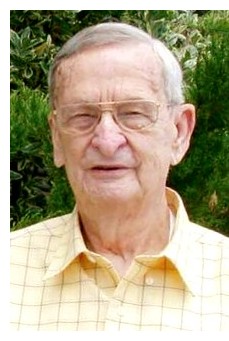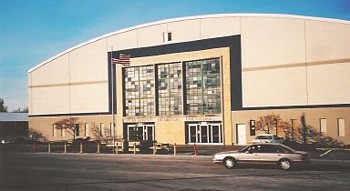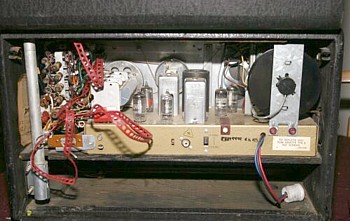Ed
Paulin and the Radios
Written
December 11, 2007
![]()
![]()
![]()
![]() Let me play you a sound clip of a local sportscaster from my youth by
the name of Ed Paulin.
Let me play you a sound clip of a local sportscaster from my youth by
the name of Ed Paulin.
![]()
![]()
![]() But let me start by showing you the 25-pound family radio from which
I originally recorded the clip. (Well, not the actual radio,
but one just like it. All the pictures in this article come
from the Internet.)
But let me start by showing you the 25-pound family radio from which
I originally recorded the clip. (Well, not the actual radio,
but one just like it. All the pictures in this article come
from the Internet.)
![]()
![]() But before that, I want to tell you about a smaller
radio. One day, its magic inspired in me a feeling of awe.
But before that, I want to tell you about a smaller
radio. One day, its magic inspired in me a feeling of awe.
![]() But first of all, let me show you our very first portable
radio. This one came to us mounted in the dashboard of a 1958
Oldsmobile!
But first of all, let me show you our very first portable
radio. This one came to us mounted in the dashboard of a 1958
Oldsmobile!
In the Fifties, battery-powered "transistor radios" first became available. These book-sized devices could bring wireless entertainment to any location, such as the beach.
|
However, most families didn't have one yet. So the Trans-Portable allowed you to take your Oldsmobile's AM radio with you and listen to it outside the car. Above the dial was a handle, pivoted near the radio's knobs. By pulling down the handle you could slide the radio out of the dash. Left behind was a hinged chrome cover plate and the larger knobs that normally adjusted the tone (right) and front/rear balance (left) of the car's regular speakers. The small volume and tuning knobs went with the Trans-Portable, and it would switch over to its own internal battery, antenna, and speaker.
|
|
|
I would have been in fifth grade when we drove the Olds to a high school basketball game at the Veterans Memorial Coliseum in Marion, Ohio. With a capacity of nearly 4,000, this is the largest arena in the area. |
|
Taking advantage of the opportunity, we carried the radio to our seats and listened to WMRN's broadcast while watching the game. At the time, it was a novel experience.
Although we were seated behind the basket in the south end zone, our view of the action was not obstructed. We could see right through the newfangled glass backboard!
Eventually
thieves discovered how easy it was to yank a Trans-Portable out of
an unattended car. Oldsmobile discontinued it after a couple of years.
|
|
|
|
The features included a little light bulb that unevenly illuminated the dial while you held a switch. Four red switches functioned as a rudimentary graphic equalizer, cutting or boosting the audio response in four different frequency ranges. |
|
The chassis was built around not transistors but tubes, miniature ones that warmed up to operating temperature in only a couple of seconds. The radio could be powered by a battery pack that slid into the lower shelf, increasing the weight of the set to about 25 pounds.
|
The spool on the right retracted the AC cord when not in use. On the left, the silver tube housed the telescoping shortwave antenna, while the perforated red cord led to the "Wave Magnet," an antenna for regular AM broadcasts that could be removed from its niche atop the cabinet and rotated to get the best reception. |
|
As a Christmas present in 1961, when I was in ninth grade, I received another piece of electronic gear: a reel-to-reel audio tape recorder. I immediately looked around for sounds to record, and I saw the Zenith. Here's part of my first recording.
|
There was one signal I never figured out; I called it an "airplane" because it sounded like a piston-engine airliner at full throttle. Was this loud noise the result of electrical interference? Well, there were many audio frequencies present, not just 60 cycles (or 60 Hertz as we would say today). Maybe it was some type of data transmission. And there was always standard AM broadcast radio, which on this December 25th was playing Christmas music, of course. |
![]()
![]()
![]()
![]() And that, finally, brings us back to Ed Paulin.
And that, finally, brings us back to Ed Paulin.
|
I set up the Zenith and my recorder to tape the end of the radio broadcast. |
|
|
As we join the action with less than 90 seconds left in the game, Richwood is trailing by 36 points. That's embarrassing. So is the fact that the Tigers are about to shoot an air ball on a free throw. |
Ed Paulin called the game for WMRN-AM, as he did for most of the Marion station's sports broadcasts. Another announcer, Bob Miller, soon joined the crew so they could air a second game on their other station, WMRN-FM.
As I recall, Ed worked alone, without an analyst. There wasn't room for one in some of the high school gyms he visited. I became a student manager for Richwood, and I remember that once at Mt. Gilead I was sitting on the "visitors' bench," which was the front row of the bleachers next to the scorers' table. The scorer actually sat in the second row of the bleachers, and Ed and his engineer Joe Peters had installed themselves and their equipment in that row as well, right behind our bench.
I also recall a post-season tournament at Delaware Hayes High School. WMRN broadcast all four games that evening from a table on the balcony in the end zone. Ed was on the air by himself for at least six hours. I was impressed by his stamina and by the fact that he was able to keep the players' names straight. Let's see, is number 12 "Smith"? No, now it's "Jones." "Smith" was number 12 two games ago.
Now, more than 40 years later, I wondered whether anyone else remembered Ed. So I Googled his name and the station's call letters, and what to my wondering eyes should appear but this article in the Stillwater, Oklahoma, NewsPress. Stillwater is where Ed is now living in retirement.
 According
to the article, Ed started broadcasting as a teenager in 1942 in
Ashland, Kentucky. He was in Marion by 1956 (the year that
16-year-old Jack Nicklaus from Columbus lost a playoff in the Junior
Chamber of Commerce championship in Fargo). He broadcast his
last play-by-play in 1966, the year after I graduated from high school.
According
to the article, Ed started broadcasting as a teenager in 1942 in
Ashland, Kentucky. He was in Marion by 1956 (the year that
16-year-old Jack Nicklaus from Columbus lost a playoff in the Junior
Chamber of Commerce championship in Fargo). He broadcast his
last play-by-play in 1966, the year after I graduated from high school.
Unable to find a better job without a college diploma, he enrolled at the University of Kentucky as a 40-year-old freshman. With a bachelor's degree, he went to Stillwater in 1971 to manage Oklahoma State's public radio station KOSU. After four years of that he went into teaching, earned his doctorate, and eventually retired in 1990 as a full professor.
Happy 80th birthday, Dr. Paulin!






